You are using an out of date browser. It may not display this or other websites correctly.
You should upgrade or use an alternative browser.
You should upgrade or use an alternative browser.
France unbuilt space launchers of the 60's and 70's
- Thread starter bgire
- Start date
bgire
ACCESS: Restricted
- Joined
- 12 July 2007
- Messages
- 36
- Reaction score
- 132
Hello!
Back on the air after an 8 month intermission.
In the meantime I switched for better printers and two months ago I've been asked by a French association to supply them with finished models of the whole range (from the early Veronique of 1950), but at the larger scale of 1:100 (originals are 1:144).
The magic of 3D designing and printing allowed to print these rockets and launchers.
I proceeded chronologically, starting with Veronique and LRBA designed rockets, then SEREB designed solid propellant rockets, then Precious Stone series of test rockets/ space launchers.
Here is a family portrait:

A portrait of the "Precious Stones":

I was then given the "Go Ahead" for the following French launcher projects of 1967-1970, which, of course, never materialized.
First batch is with the so-called "Super Diamant", a range of rockets designed as upgrades of Diamant, replacing original stages with new powder powered ones from the military, some recycling the Coralie second stage of the Europa programme and even a fairing borowed to British Black Arrow programme (Black Diamant)
Printing at 1:100:


After assembly they get a coat of primer:

Followed by a white coat:

To be continued...
Back on the air after an 8 month intermission.
In the meantime I switched for better printers and two months ago I've been asked by a French association to supply them with finished models of the whole range (from the early Veronique of 1950), but at the larger scale of 1:100 (originals are 1:144).
The magic of 3D designing and printing allowed to print these rockets and launchers.
I proceeded chronologically, starting with Veronique and LRBA designed rockets, then SEREB designed solid propellant rockets, then Precious Stone series of test rockets/ space launchers.
Here is a family portrait:
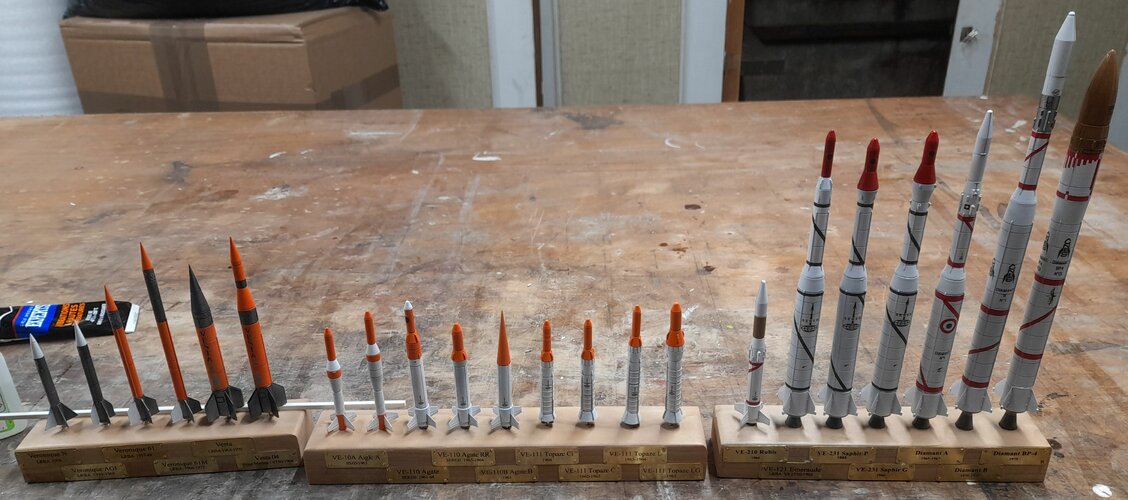
A portrait of the "Precious Stones":
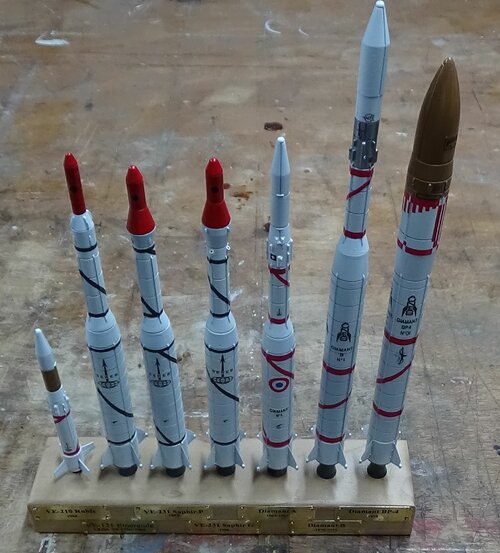
I was then given the "Go Ahead" for the following French launcher projects of 1967-1970, which, of course, never materialized.
First batch is with the so-called "Super Diamant", a range of rockets designed as upgrades of Diamant, replacing original stages with new powder powered ones from the military, some recycling the Coralie second stage of the Europa programme and even a fairing borowed to British Black Arrow programme (Black Diamant)
Printing at 1:100:
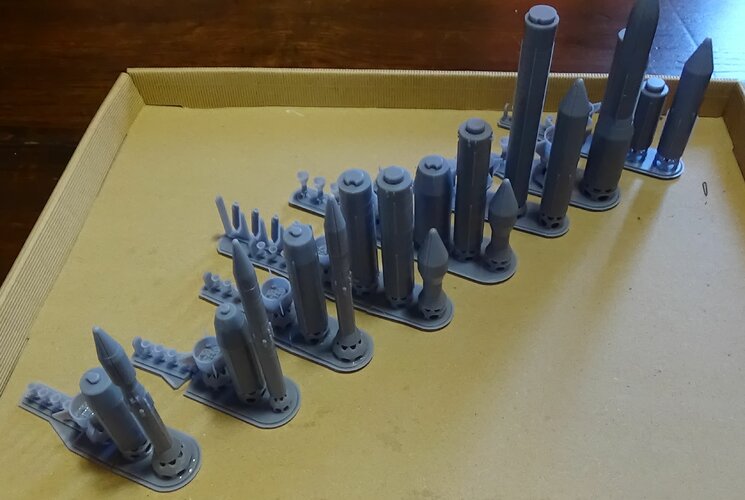
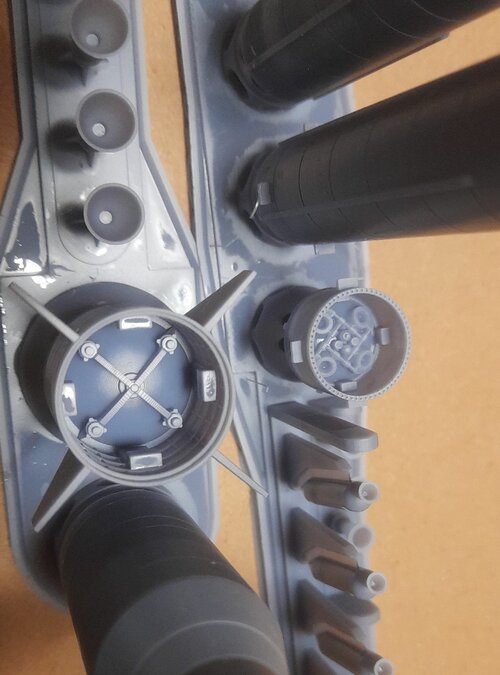
After assembly they get a coat of primer:
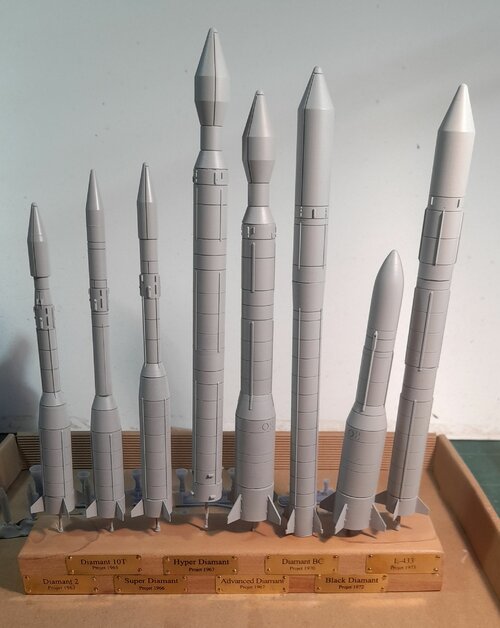
Followed by a white coat:
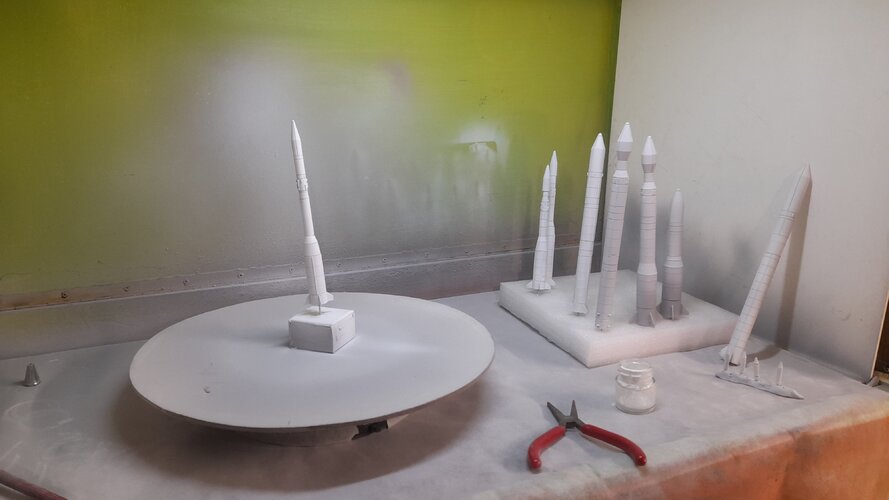
To be continued...
martinbayer
ACCESS: Top Secret
- Joined
- 6 January 2009
- Messages
- 3,334
- Reaction score
- 3,797
Simply stunning and beautiful!
I readily second the above opinion. Hail 3 D priting and a talented modeler, who lifted all those forgotten rockets out of Flight International - and oblivion.
Meanwhile I'm counting the additional lives I would need to
- master Orbiter and Kerbal
- create a space blog
- go 3 D printing at 1/72 scale
And countless additional aerospace nerdery.
Meanwhile I'm counting the additional lives I would need to
- master Orbiter and Kerbal
- create a space blog
- go 3 D printing at 1/72 scale
And countless additional aerospace nerdery.
bgire
ACCESS: Restricted
- Joined
- 12 July 2007
- Messages
- 36
- Reaction score
- 132
Thanks gentlemen!
More progress today:
Masking with Parafilm to paint the non-white areas:

Laying Alclad2 black undercoat for metal areas:

Laying metal parts:

The Black Diamant (Coralie first stage from the Europa programme, powder second stage and composite fairing from the British Black Arrow programme:

Next step: laying decals. As these are never built project I'll have to somewhat improvise for fun.
To be continued.
More progress today:
Masking with Parafilm to paint the non-white areas:
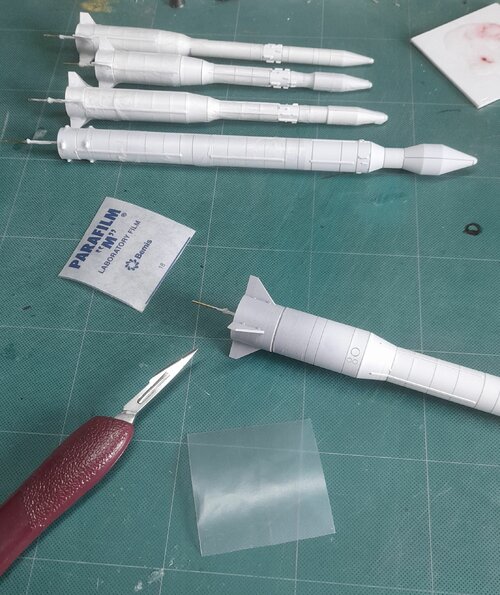
Laying Alclad2 black undercoat for metal areas:
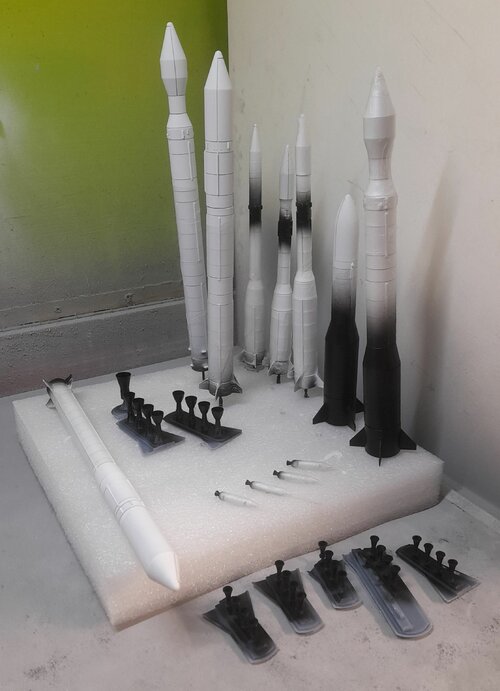
Laying metal parts:
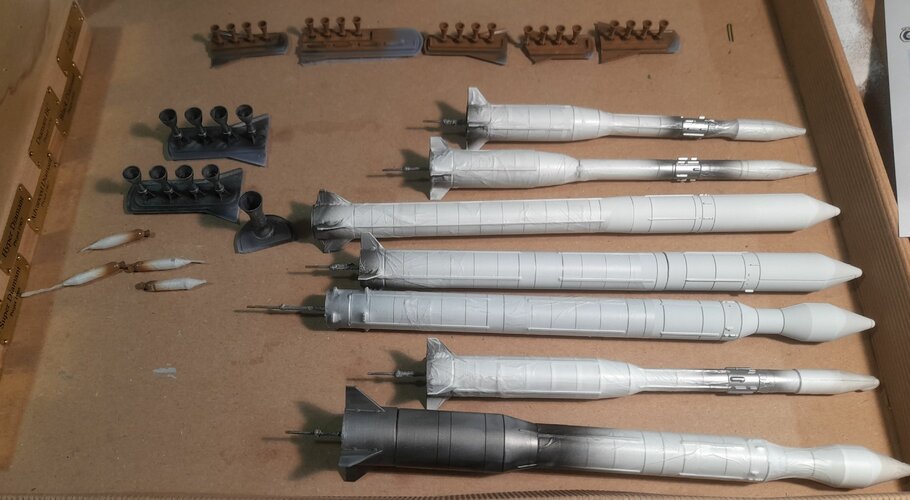
The Black Diamant (Coralie first stage from the Europa programme, powder second stage and composite fairing from the British Black Arrow programme:
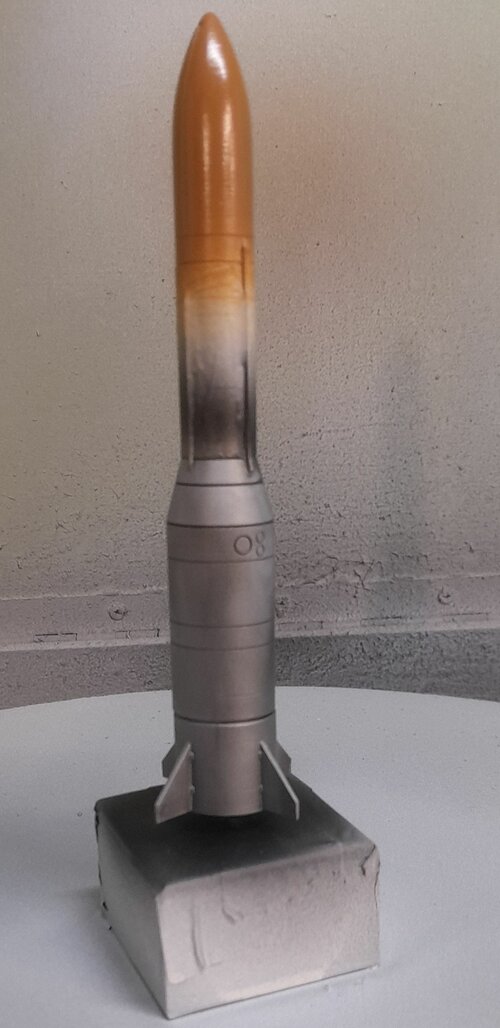
Next step: laying decals. As these are never built project I'll have to somewhat improvise for fun.
To be continued.
bgire
ACCESS: Restricted
- Joined
- 12 July 2007
- Messages
- 36
- Reaction score
- 132
Here is the final run of this marathon.
Decals are layered. As these projects never finalized I took some artistic licence, inspired by period liveries:

The, the rockets were given two coats of glossy VMS varnish:

Multiple rocket nozzles are installed:

At last the rockets are secured on their wooden base:



Description of vehicles:
In the list below "P" stand for powder powered stage, "L" for liquid powered. P10 is a powder stage with 10tons of propellant.
Diamant 2: based on a military P10 first stage and two «to be designed»
cryogenic stages H2.2 and H0.5. 385kg payload in low orbit. Lift-off weight: 18t.
Diamant 10T: a P10, a Topaze second stage and a small P0.68 with a payload of 130kg in low orbit. Lift-off weight: 15.815t.
Super Diamant: a new P16 stage, a Topaze and a small P0.9 with a payload of 200kg in low orbit. Lift-off weight: 20.9t.
Hyper Diamant: a P16, a P10, a P4 Rita 1 (from the ICBM programme) and a P1.5 to send 55kg in geostationnary orbit. Lift-off weight: 38t.
Advanced Diamant: an L10 (Coralie), a P10, a P4 Rita 1 and a P1.5. Lift-off weight: 25t.
Diamant BC: this was the natural follow-on of Diamant B before being cancelled for lack of funds and replaced with Diamant BP4: An L17 Améthyste, a P4 Rita 1, a P0.68 and a P0.28 to carry 250kg in low orbit. Lift-off weight: 127.26t.
Black Diamant: a curious design with a L10 Coralie first stage, a second stage from the British Black Arrow programme and a P0.68 housed in a Black Arrow fairing (the very one to be used aboard Diamant BP4) to lift 190kg in low orbit. Lift-off weight: 15.3t.
L433: a full solid propellant launcher: a P16, a P10, a P6 Rita 2 and a P0.68 to carry 60kg in geostationnary orbit. Lift-off weight: 35.5t.
Decals are layered. As these projects never finalized I took some artistic licence, inspired by period liveries:
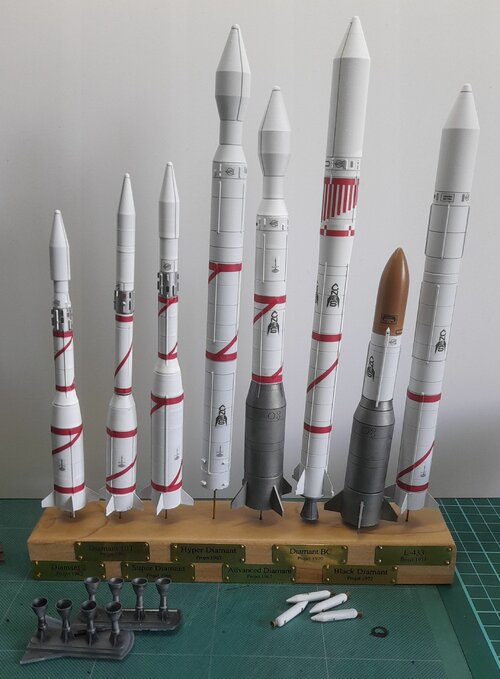
The, the rockets were given two coats of glossy VMS varnish:
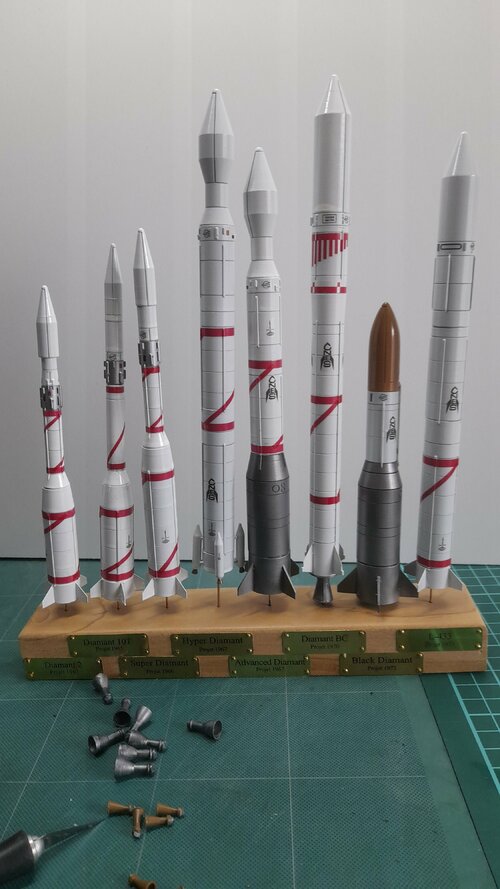
Multiple rocket nozzles are installed:
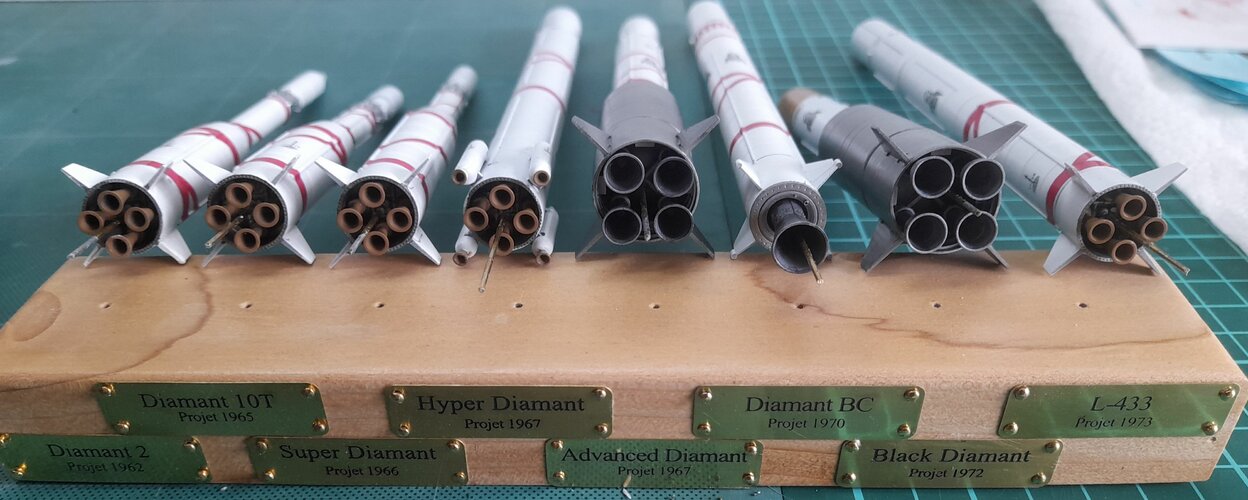
At last the rockets are secured on their wooden base:
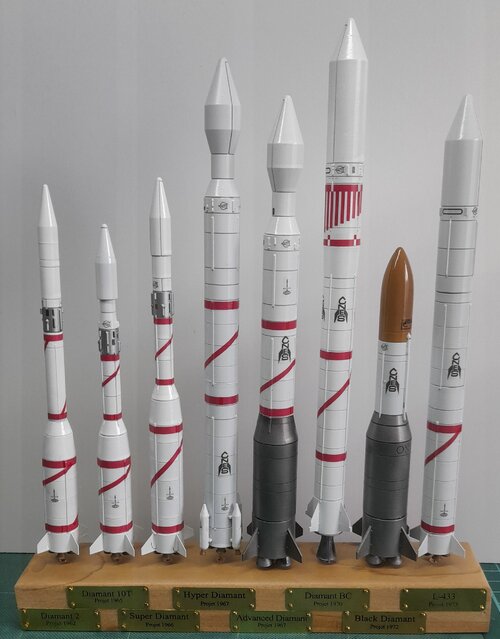
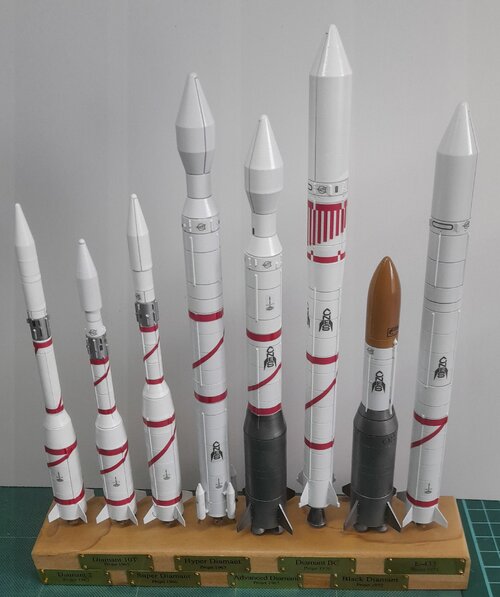
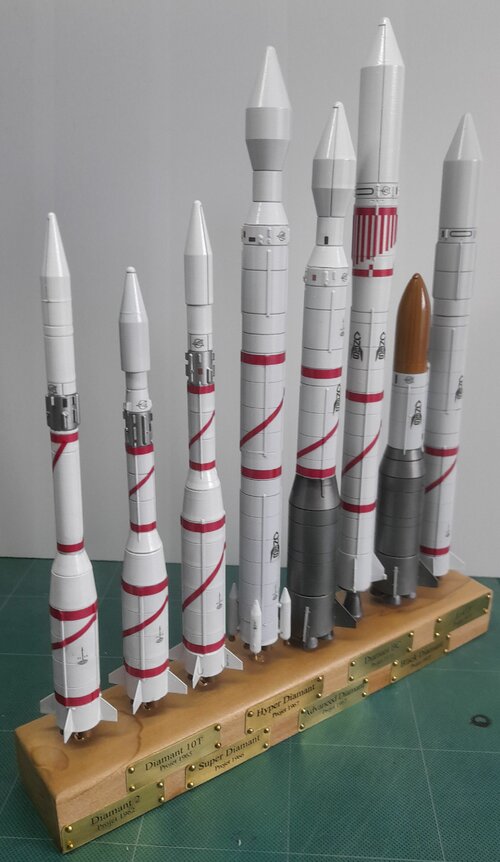
Description of vehicles:
In the list below "P" stand for powder powered stage, "L" for liquid powered. P10 is a powder stage with 10tons of propellant.
Diamant 2: based on a military P10 first stage and two «to be designed»
cryogenic stages H2.2 and H0.5. 385kg payload in low orbit. Lift-off weight: 18t.
Diamant 10T: a P10, a Topaze second stage and a small P0.68 with a payload of 130kg in low orbit. Lift-off weight: 15.815t.
Super Diamant: a new P16 stage, a Topaze and a small P0.9 with a payload of 200kg in low orbit. Lift-off weight: 20.9t.
Hyper Diamant: a P16, a P10, a P4 Rita 1 (from the ICBM programme) and a P1.5 to send 55kg in geostationnary orbit. Lift-off weight: 38t.
Advanced Diamant: an L10 (Coralie), a P10, a P4 Rita 1 and a P1.5. Lift-off weight: 25t.
Diamant BC: this was the natural follow-on of Diamant B before being cancelled for lack of funds and replaced with Diamant BP4: An L17 Améthyste, a P4 Rita 1, a P0.68 and a P0.28 to carry 250kg in low orbit. Lift-off weight: 127.26t.
Black Diamant: a curious design with a L10 Coralie first stage, a second stage from the British Black Arrow programme and a P0.68 housed in a Black Arrow fairing (the very one to be used aboard Diamant BP4) to lift 190kg in low orbit. Lift-off weight: 15.3t.
L433: a full solid propellant launcher: a P16, a P10, a P6 Rita 2 and a P0.68 to carry 60kg in geostationnary orbit. Lift-off weight: 35.5t.
Silencer1
That now I am the Ruler of the Queen's Navee!
- Joined
- 3 August 2009
- Messages
- 897
- Reaction score
- 582
Very impressive and convincing! Reminds me the company-produced presentation models, intended to high-ranked decision makers. Nice composition of plastic, paint, wood and metal.Keep up a good work!Here is the final run of this marathon.
Decals are layered. As these projects never finalized I took some artistic licence, inspired by period liveries:
View attachment 699243
The, the rockets were given two coats of glossy VMS varnish:
View attachment 699244
Multiple rocket nozzles are installed:
View attachment 699245
At last the rockets are secured on their wooden base:
View attachment 699246
View attachment 699247
View attachment 699248
Description of vehicles:
In the list below "P" stand for powder powered stage, "L" for liquid powered. P10 is a powder stage with 10tons of propellant.
Diamant 2: based on a military P10 first stage and two «to be designed»
cryogenic stages H2.2 and H0.5. 385kg payload in low orbit. Lift-off weight: 18t.
Diamant 10T: a P10, a Topaze second stage and a small P0.68 with a payload of 130kg in low orbit. Lift-off weight: 15.815t.
Super Diamant: a new P16 stage, a Topaze and a small P0.9 with a payload of 200kg in low orbit. Lift-off weight: 20.9t.
Hyper Diamant: a P16, a P10, a P4 Rita 1 (from the ICBM programme) and a P1.5 to send 55kg in geostationnary orbit. Lift-off weight: 38t.
Advanced Diamant: an L10 (Coralie), a P10, a P4 Rita 1 and a P1.5. Lift-off weight: 25t.
Diamant BC: this was the natural follow-on of Diamant B before being cancelled for lack of funds and replaced with Diamant BP4: An L17 Améthyste, a P4 Rita 1, a P0.68 and a P0.28 to carry 250kg in low orbit. Lift-off weight: 127.26t.
Black Diamant: a curious design with a L10 Coralie first stage, a second stage from the British Black Arrow programme and a P0.68 housed in a Black Arrow fairing (the very one to be used aboard Diamant BP4) to lift 190kg in low orbit. Lift-off weight: 15.3t.
L433: a full solid propellant launcher: a P16, a P10, a P6 Rita 2 and a P0.68 to carry 60kg in geostationnary orbit. Lift-off weight: 35.5t.
bgire
ACCESS: Restricted
- Joined
- 12 July 2007
- Messages
- 36
- Reaction score
- 132
Thanks, guys, for your support.
Well... seems my customer will soon order the following 1966-1968 medium and heavy projects of French launchers.
Soooo... this thread is probably to be continued.
Not counting my parallel build of the same at 1:144.
_Bruno
Well... seems my customer will soon order the following 1966-1968 medium and heavy projects of French launchers.
Soooo... this thread is probably to be continued.
Not counting my parallel build of the same at 1:144.
_Bruno
bgire
ACCESS: Restricted
- Joined
- 12 July 2007
- Messages
- 36
- Reaction score
- 132
Aside this 1:100 scale production for a customer, I'm now pursuing design, printing and assembly of the same range for me at 1:144 scale.
Time, now to concentrate on the larger 1966-1968 projects.
First the numerous SEREB designed projects, based on multiple combination of existing or about to be developped solid fueled stages:

The printed parts at 1:144:


Then come the LRBA designed projects, based on liquid fueled cluster first stages based on existing Diamant Améthyste and projected larger versions:

Compared to my earlier prints (shown at the begining of this subject) many parts have been redesigned, correcting errors, enhancing details, making further assembly easier and more geometrically accurate. I managed to withdraw any photo etched part or brass rod, thank to the tremendous progress of 3D printers over the last five years



At last the "Super heavy" launcher projects from LRBA of 1968:


Redesigned parts: this Super Vulcain interstage structure replaces a former ensemble of 4 resin, 8 photo etched and 56 brass rod parts with one single more sturdy printed part


Another interstage frame:

At last the printing phase is finished:

To be continued...
Time, now to concentrate on the larger 1966-1968 projects.
First the numerous SEREB designed projects, based on multiple combination of existing or about to be developped solid fueled stages:

The printed parts at 1:144:


Then come the LRBA designed projects, based on liquid fueled cluster first stages based on existing Diamant Améthyste and projected larger versions:

Compared to my earlier prints (shown at the begining of this subject) many parts have been redesigned, correcting errors, enhancing details, making further assembly easier and more geometrically accurate. I managed to withdraw any photo etched part or brass rod, thank to the tremendous progress of 3D printers over the last five years



At last the "Super heavy" launcher projects from LRBA of 1968:


Redesigned parts: this Super Vulcain interstage structure replaces a former ensemble of 4 resin, 8 photo etched and 56 brass rod parts with one single more sturdy printed part


Another interstage frame:

At last the printing phase is finished:

To be continued...
martinbayer
ACCESS: Top Secret
- Joined
- 6 January 2009
- Messages
- 3,334
- Reaction score
- 3,797
Outstanding!
Discovering this thread.
Insane modelling work.
I wasn't even aware of the existence of the projects. If anyone has useful link to allow to get more knowledge on these launchers project, I would be happy to have additionnal stuff to read.
Insane modelling work.
I wasn't even aware of the existence of the projects. If anyone has useful link to allow to get more knowledge on these launchers project, I would be happy to have additionnal stuff to read.
Flight Global archive once was online for free, but this belongs to the past, unfortunately.
Long story short: the ultimate Diamant development project was SuperVulcain B: the size of a Soyuz rocket, and an alternative to the doomed Europa II when it ran in serious trouble in 1968.
Imagine 8, then 4, Diamant L17 "Améthyste" press-fed stages, each with a 35-tons thrust Valois, clustered Saturn IB style.
Between the "basic" Diamant and that beast SuperVulcain B were a whole bunch of intermediate launch vehicles, clusters of Diamant L17s (Catherine, Octavia...)
There are also two different families loosely related to it
- the hydrogen Diamants
- the solid-fuel Diamants
The "ultimate Diamant", Europa and early Ariane studies (with the M40 / M55 / Viking being fired circa 1969) all crossed path, somewhat, around the year 1969.
It is a remarquable "crossroad" in European rocketry history. France couldn't fund Supervulcain B all lone, so Europa was the (money) way to go except it was politically and technically flawed, so second try led to ESA and Ariane, after 1973.
Long story short: the ultimate Diamant development project was SuperVulcain B: the size of a Soyuz rocket, and an alternative to the doomed Europa II when it ran in serious trouble in 1968.
Imagine 8, then 4, Diamant L17 "Améthyste" press-fed stages, each with a 35-tons thrust Valois, clustered Saturn IB style.
Between the "basic" Diamant and that beast SuperVulcain B were a whole bunch of intermediate launch vehicles, clusters of Diamant L17s (Catherine, Octavia...)
There are also two different families loosely related to it
- the hydrogen Diamants
- the solid-fuel Diamants
The "ultimate Diamant", Europa and early Ariane studies (with the M40 / M55 / Viking being fired circa 1969) all crossed path, somewhat, around the year 1969.
It is a remarquable "crossroad" in European rocketry history. France couldn't fund Supervulcain B all lone, so Europa was the (money) way to go except it was politically and technically flawed, so second try led to ESA and Ariane, after 1973.
Quick search on the forum with "Supervulcain" brings two threads. https://www.secretprojects.co.uk/search/465724/?q=supervulcain&o=relevance
TheKutKu
ACCESS: Secret
- Joined
- 13 February 2023
- Messages
- 462
- Reaction score
- 1,375
this is truly outstanding work, the quality is like a model
Actually does someone have bgire’s " The French National Space Programme 1950-1975" from JBIS 40 that he linked in the first post of this thread ? The link is deadQuick search on the forum with "Supervulcain" brings two threads. https://www.secretprojects.co.uk/search/465724/?q=supervulcain&o=relevance
bgire
ACCESS: Restricted
- Joined
- 12 July 2007
- Messages
- 36
- Reaction score
- 132
TheKutKu
ACCESS: Secret
- Joined
- 13 February 2023
- Messages
- 462
- Reaction score
- 1,375
Thank you so much! These are really beautiful cutaways, they almost feel out of place in a scientific publication, incredible.Hello TheKutKu,
Here is the JBIS 40 article I co-wrote around 1983 and which originated my "quest" for modeling these forgotten projects.
All drawings are mine, done "the ol'way" using China ink... that was eight year before I got my first computer!
Regent is really interesting , from what I’ve read it had quite a bit of work done on it at CNES from mid 63 to mid 65. I wonder if it was because it would have been their first actual launcher, since Diamant A was not really theirs.
Last edited:
bgire
ACCESS: Restricted
- Joined
- 12 July 2007
- Messages
- 36
- Reaction score
- 132
After a six month break, I'm back on my French launchers project, this time at 1:144 scale.
Previously on this subject:
My original project (1982) was a detailled technical survey which went published in the Journal of the British Interplanetary Society by 1987. At that time I began thinking of doing models of these launchers... sometimes.
The challenge was: which scratch technique to use? By these early times I was just aware of photo etching and my first resin castings weren't really presentable.
In 2010 I discovered 3D drawing, then two years later 3D printing (from a company... expensive... not great resolution).
In 2017 I bought my first 3D printer and set about producing masters of these machines for reproduction by resin casting. These are the photos above. Accuracy was good but the finished product (moulded) still left something to be desired.
In 2022 I bought my third printer and this time I discovered excellent precision (19 microns) and a printing cost so affordable that it became possible to produce direct prints. Gone was the expensive and time-consuming moulding phase.
The new printing precision meant that the drawings could be completely reworked for a fourth version with even greater finesse and precision. In fact, between 2017 and 2023 I went from a resolution of 84 microns to 19 microns, and I had to redesign the most of it.
So the final assembly of these forty launchers is finally complete.
We start by printing the last version:





The interstage trusses of the big LRBA projects of 1966-68 were reworked, refined and printed. The first versions were made entirely of PE, which made assembly extremely difficult, if not impossible. Well... impossible in fact.





L'impression se poursuit :






I'm taking this opportunity to solve a support problem: the biggest launchers have multiple engines at the base and to make them more visible I've taken inspiration from a contemporary launch cradle for American Titan rockets to invent a support that goes well with it:





Start of assembly (in real chronological order) :


The interlocking studs on the different stages are not long enough (2mm), even though they also act as locators for the relative orientation of the two elements. I'm still managing, but precise alignment on the axis is a bit tricky. This will give rise to a fifth version of the drawings with tenons 3 times longer, which will be used for future prints. This proves the old adage: always make a prototype assembly before moving on to the final assembly.


On the right, the first rockets on their cradle:


The first part is finished, containing all the launchers that actually existed, from Veronique to Diamant BP4. The painting phase begins with an AK black primer:

I then moved on to the launcher projects of 1965-1968, which included many more parts.
First, the SEREB solid propellants launchers: Régent, Diogène 2, Turquoise C and H.


Then the LRBA's liquid fuel launchers:
Carmen :

Vulcain C, P and H :



Bacchus and Supervulcain 2 :


After assembly and priming, this second group joined the first for general painting.
After masking the parts that will remain metallic with Parafilm, 4 coats of Tamiya XF-2 matt white are applied. 4 hours of work and two large 23ml pots of paint, but the result is there:



Close-up of the Hyper Diamant boosters. Note the nozzles, previously painted light brown and masked with Parafilm, which is also used to fix them with toothpicks. Each booster is 8mm long and its nozzle about 1.5mm:

The other elements are painted with Alclad2 on a black base (Steel, Airframe aluminium, White aluminium, Magnesium).




Three more masking-painting operations for the other colours and we'll move on to the final assembly.
Previously on this subject:
My original project (1982) was a detailled technical survey which went published in the Journal of the British Interplanetary Society by 1987. At that time I began thinking of doing models of these launchers... sometimes.
The challenge was: which scratch technique to use? By these early times I was just aware of photo etching and my first resin castings weren't really presentable.
In 2010 I discovered 3D drawing, then two years later 3D printing (from a company... expensive... not great resolution).
In 2017 I bought my first 3D printer and set about producing masters of these machines for reproduction by resin casting. These are the photos above. Accuracy was good but the finished product (moulded) still left something to be desired.
In 2022 I bought my third printer and this time I discovered excellent precision (19 microns) and a printing cost so affordable that it became possible to produce direct prints. Gone was the expensive and time-consuming moulding phase.
The new printing precision meant that the drawings could be completely reworked for a fourth version with even greater finesse and precision. In fact, between 2017 and 2023 I went from a resolution of 84 microns to 19 microns, and I had to redesign the most of it.
So the final assembly of these forty launchers is finally complete.
We start by printing the last version:





The interstage trusses of the big LRBA projects of 1966-68 were reworked, refined and printed. The first versions were made entirely of PE, which made assembly extremely difficult, if not impossible. Well... impossible in fact.





L'impression se poursuit :






I'm taking this opportunity to solve a support problem: the biggest launchers have multiple engines at the base and to make them more visible I've taken inspiration from a contemporary launch cradle for American Titan rockets to invent a support that goes well with it:





Start of assembly (in real chronological order) :


The interlocking studs on the different stages are not long enough (2mm), even though they also act as locators for the relative orientation of the two elements. I'm still managing, but precise alignment on the axis is a bit tricky. This will give rise to a fifth version of the drawings with tenons 3 times longer, which will be used for future prints. This proves the old adage: always make a prototype assembly before moving on to the final assembly.


On the right, the first rockets on their cradle:


The first part is finished, containing all the launchers that actually existed, from Veronique to Diamant BP4. The painting phase begins with an AK black primer:

I then moved on to the launcher projects of 1965-1968, which included many more parts.
First, the SEREB solid propellants launchers: Régent, Diogène 2, Turquoise C and H.


Then the LRBA's liquid fuel launchers:
Carmen :

Vulcain C, P and H :



Bacchus and Supervulcain 2 :


After assembly and priming, this second group joined the first for general painting.
After masking the parts that will remain metallic with Parafilm, 4 coats of Tamiya XF-2 matt white are applied. 4 hours of work and two large 23ml pots of paint, but the result is there:



Close-up of the Hyper Diamant boosters. Note the nozzles, previously painted light brown and masked with Parafilm, which is also used to fix them with toothpicks. Each booster is 8mm long and its nozzle about 1.5mm:

The other elements are painted with Alclad2 on a black base (Steel, Airframe aluminium, White aluminium, Magnesium).




Three more masking-painting operations for the other colours and we'll move on to the final assembly.
Similar threads
-
-
French Super V-2 or Project 4212.
- Started by Michel Van
- Replies: 2
-
-
List of reference books by period or manufacturer: Belgian aircraft
- Started by c460
- Replies: 7
-
Early European earth observation satellites projects.
- Started by TheKutKu
- Replies: 1
















